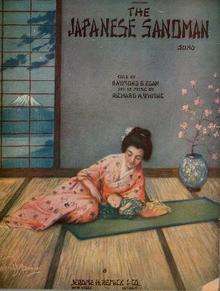The Japanese Sandman
"The Japanese Sandman" is a song from 1920, composed by Richard A. Whiting and with lyrics by Raymond B. Egan.[1][2] The song was first popularized on Vaudeville by Nora Bayes, and then sold millions of copies as the B-side for the song "Whispering".[3]
| "The Japanese Sandman" | |
|---|---|
 | |
| Song | |
| Songwriter(s) | Composer: Richard A. Whiting Lyricist: Raymond B. Egan |
An instrumental version of "The Japanese Sandman", being performed by Paul Whiteman and His Ambassador Orchestra in August 1920. | |
Content
The song is about a sandman from Japan, who exchanges yesterdays for tomorrows. The number has a very Oriental atmosphere, and is similar to many other songs from the interwar period who sing about a dreamy, exotic setting.
Nora Bayes made a popular recording of the song in 1920. The song was Paul Whiteman's first record and sold over two million copies. It has been subsequently performed by several musical artists like Art Hickman, Benny Goodman, Bix Beiderbecke, Artie Shaw, Earl Hines, Paul Young, Django Reinhardt, the Andrews Sisters, Freddy Gardner, Freddy Sunder, and in 2010, a high-fidelity recording of Whiteman's historic arrangement, by Vince Giordano and his Nighthawks Orchestra.
Additionally, the song was recorded by the Nazi German propaganda band Charlie and his Orchestra. For propaganda reasons, the lyrics were changed through references to the Japanese Empire.
In popular culture
- The song was often used in American cartoons from the 1930s to the 1940s, such as 1942's The Ducktators, usually to mock Japanese characters, due to the ongoing war between the United States and Imperial Japan.
- An orchestral version is heard in the musical film Rose of Washington Square (1939), starring Alice Faye.[4]
- In the 1947 Disney cartoon "Cat Nap Pluto," both Pluto and Figaro are visited by figurative "sandman" likenesses of themselves in coolie hats, seeking to bring on sleep. These references are purely visual, however, as the Whiting song is not heard.
- The Japanese boxer Harold Hoshino was nicknamed "The Japanese Sandman" in the 1930s.[5]
- In 1944 a version of the song plays out the submarine's speaker system to the crew in Destination Tokyo.
- Hoagy Carmichael performed the song on ukulele in the 1952 film Belles on Their Toes.
- Whiteman's original can also be heard in the 1969 film They Shoot Horses, Don't They? and on The Masked Marauders album from the same year.
- Frank Zappa quotes the song on the final track of his album Joe's Garage (1979): "A Little Green Rosetta".
- Saint Etienne make a reference to this in their song B92 in their 2002 album Finisterre.
- The song appears in the 2009 fantasy film The Imaginarium of Doctor Parnassus.
- Instrumental versions appeared in almost every one of the first five episodes of the HBO series Boardwalk Empire. A version with lyrics was featured in the show on October 24, 2010.
References
- Michigan History Magazine. 85. Michigan Department of State. 2001. p. 53.
- Irene Kahn Atkins (1 February 1983). Source music in motion pictures. Fairleigh Dickinson University Press. p. 63. ISBN 978-0-8386-3076-1.
- Marvin E. Paymer; Don E. Post (1999). Sentimental Journey: Intimate Portraits of America's Great Popular Songs, 1920-1945. Noble House Publishers. p. 11. ISBN 978-1-881907-09-1.
- "The Japanese Sandman" orchestral recording, audio file only, from Rose of Washington Square (1939) on YouTube
- Svinth, Joseph R. (June 2002). "Boxing: Harold Hoshino, the Japanese Sandman". Journal of Combative Sport. Retrieved 2011-03-07.
Sources
- The lyrics (http://lyricsplayground.com/alpha/songs/t/thejapanesesandman.shtml)
- About the song (http://parlorsongs.com/issues/2003-1/thismonth/featureb.php)
- A list with covers of the song (https://web.archive.org/web/20110712215654/http://honkingduck.com/mc/discography?field_combo_value=&field_selection_value=japanese+sandman)